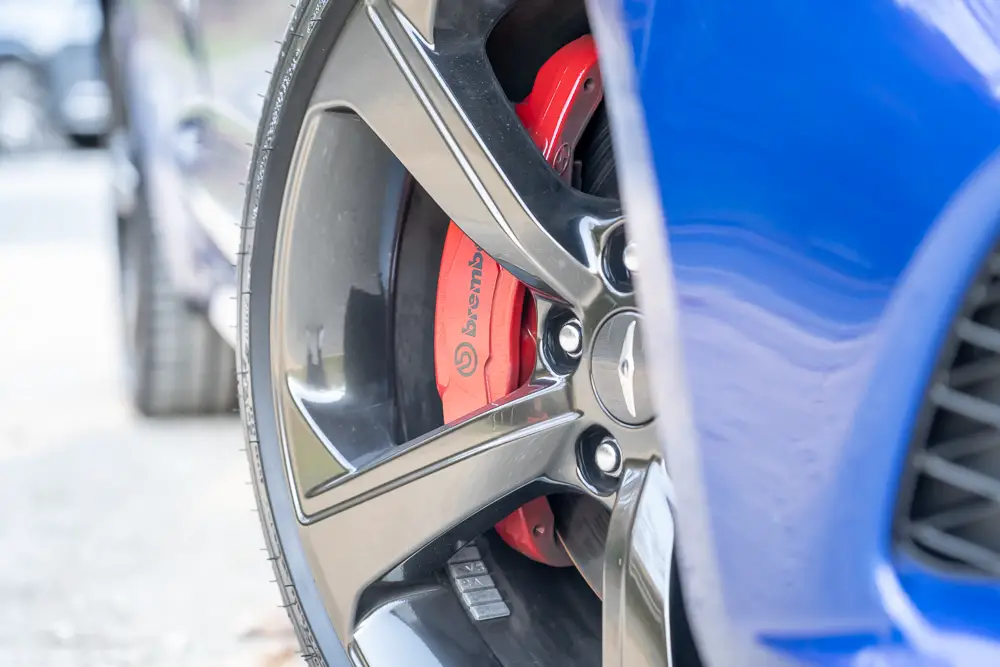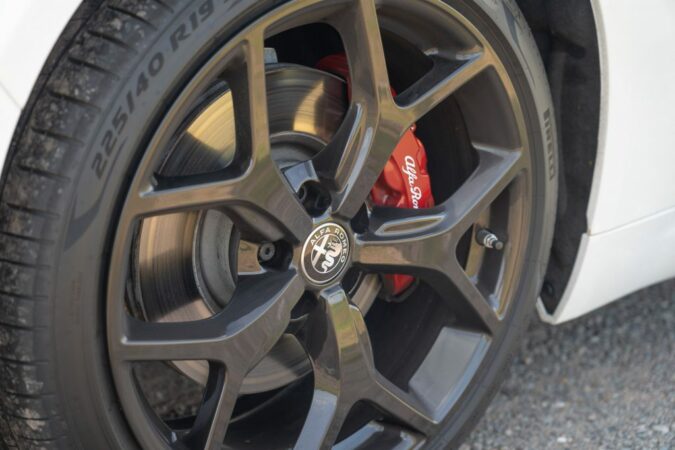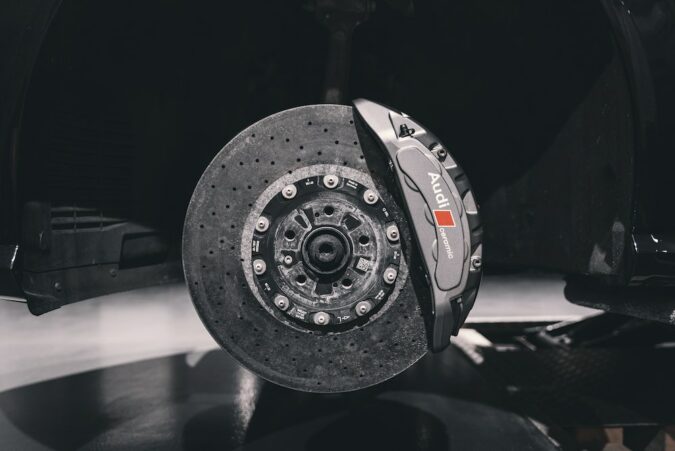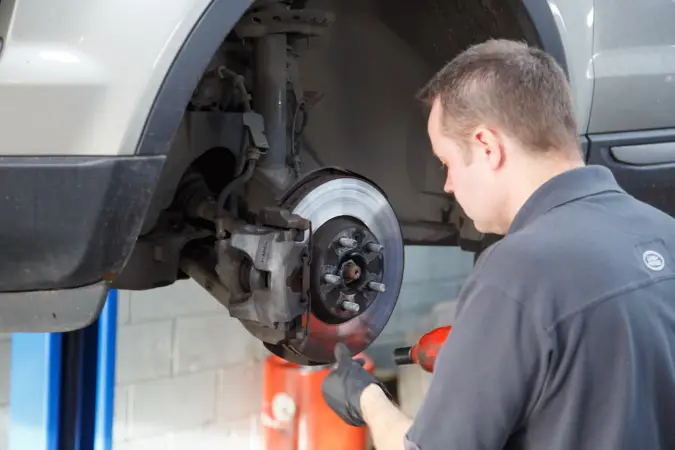Are you feeling that your brakes are not working as they should? The car brakes but the pedal feels soft, like a sponge? If this is the case and you are in this situation, you probably have spongy brakes. That’s why we are going to help you out with this problem.
Having a problem like this can be quite frustrating to deal with. Why I’m saying this? Well, because the brakes are important. Brakes make you stop and if you start to feel some abnormalities, then it is high time for you to start addressing the problem sooner or later. You just don’t want your brakes to fail completely and you lose your braking ability.
So, monitoring these symptoms of spongy brakes is key if you want to diagnose and solve your problem quickly and effectively without much effort. Also, not to forget that these brakes are a safety hazard. A brake pedal should be nice and firm. With only a little effort you should be able to come to a stop. If not then you probably have a big problem. And that’s why we are going to help you out with your trouble.
First, we are going to elaborate more on this problem and learn more about spongy brakes. Then we will discuss how the braking system works and understand the method of action and components that are inside. Later, we will discuss the symptoms of spongy brakes as well as the causes of this problem happening. Later on, we will move into diagnosing and fixing the matter. So, if you want to learn more, follow along till the end.
What Are Spongy Brakes?
Now before we take things further and cover some more complex topics. Let’s first elaborate on the basics of this problem with spongy brakes. This will be quite useful for beginners who are not familiar with the problem and want to learn more. If you feel that you are prepared and understand the issue, you can move on to the following chapters where we will elaborate on the causes. If not, keep up with us for a bit more.
Spongy brakes are a problem that is affecting your braking system. This problem usually happens inside the cabin. More precisely on your brake pedal.
When you have spongy brakes, the brake pedal is not feeling nice and firm anymore, it starts to feel spongy or squishy. You are feeling like you are pressing a spring instead of a brake pedal. And frankly, this is not a good feeling for a driver who is experienced and has driven a lot of miles.
And for a reason. Brakes shouldn’t be soft and spongy but nice and firm. Unlike the other pedals like the gas or clutch pedal, if you drive a manual, the brake pedal is not fully pressed in.
Whenever the travel of this pedal is too long, this means that there is a problem inside of your braking system. And in some cases, this problem can be very serious and is absolutely dangerous to drive a car like this.
Normally a brake system has a lot of protection to prevent a complete brake failure. But still, you should not ignore this spongy brakes problem and try to solve it as soon as possible. But first, let’s cover the basics of the braking system and see how it works in practice.
How Does The Braking System Works?
Now before we cover the symptoms of the spongy brakes. Let’s discuss how the braking system works. This would be extra useful for beginners that don’t know how their brakes work. A better understanding of the mechanicals will aid you in diagnosing the problem much quicker than previously anticipated. So, if you want to learn more follow along.
The brake system is basically a hydraulic system. It works with the help of a hydraulic fluid also known as DOT. There are various types of this fluid. Namely, DOT 3, DOT 4, and DOT 5. All these fluids are different and you should not use them interchangeably because they have different characteristics.
The important thing to note is that this hydraulic fluid aids the braking in your car. This fluid does all the heavy lifting when it comes to stopping the vehicle. But from what components this system is composed of?
Well, this system is composed of the master cylinder which is the brain of the system. This is a mechanical device with a spring and a piston inside. It has two circuits that serve one side of the vehicle. This is made to prevent complete failure of the brakes.
Then this master cylinder is connected to the brake booster. The brake booster is the one that increases the force you apply from the brake pedal. This booster is also known as a brake servo or vacuum booster.
Next are the brake lines that go to each wheel and they are bolted to the brake calipers. Whenever you press the brakes, the fluid travels into the calipers and opens the pistons. Applying hydraulic force on the pistons to press the pads. But what about spongy brakes? More on that in a bit.
Spongy Brakes Symptoms
Now after we have some understanding of the problem with spongy brakes and how brakes work in general. Let’s dedicate a few chapters to the symptoms of this problem.
It is worth noting that there are a few of them and it is often useful for you to know them if you want to diagnose the problem with the spongy brakes. After we cover the symptoms, we will move to the causes of why this problem happens in the first place. Now, let’s start elaborating.
1. Brake Light On
The first symptom that you will notice when you have spongy brakes is when the brake light is on. As you know modern cars are all computerized and they can detect whenever there is a problem with your brake system.
So, the computer will pop up an error message on the dashboard. This is no ordinary check engine light but a brake light. This light indicates that there is a problem with the brakes, unlike the check engine light which could mean a ton of different things. So, beware of this light and whenever you notice this light flashing or illuminated. It is important to take up some action and try to solve the spongy brakes problem.
2. Brake Pedal Feels Like You Press A Spring
The second most common symptom of spongy brakes is when you press on the pedal and it basically looks like you are pressing a spring. Thus the name spongy brakes.
It’s like you press on a sponge. An awkward feel for a brake pedal. Because as everybody knows, brakes feel hard and should not be soft by any means.
So, whenever your brake pedal is acting like a spring or a sponge, this means that you have a problem with spongy brakes. But what could cause this problem in the first place? Well, that’s what we are going to cover later in the article after we finish the symptoms of this spongy brakes problem.
3. Brakes Don’t Feel Like They Are Doing Their Job Right
Another symptom of spongy brakes is poor performance. They just feel like faded and the car doesn’t want to brake as it used to in the past when the brakes were in mint condition.
This could be quite dangerous though. Imagine that you need to come to a stop and for some reason, the brakes don’t work as they need to.
This will result in an accident and you could possibly hurt yourself. This doesn’t always have to be the case. But if one or more brake lines are out of use because of a bad circuit in the master cylinder you will start to feel these things.
The wear and tear of the pads on one of the sides could be far greater than on the other and the car could also pull on one side after heavy braking. All these symptoms are associated with spongy brakes.
So, beware of these symptoms that we discussed above which are the poor performance under braking, brake light, and the situation of the spongy brakes. Now let’s move on to the next thing and that is the cause of the spongy brakes.
Causes For Spongy Brakes
Now after we covered the symptoms of spongy brakes, let’s discuss the causes for spongy brakes. Knowing the causes is going to help you immensely when it comes to diagnosing and fixing the issue. Since you will know where to look for your problem and diagnose and troubleshoot the issue.
After covering the causes for the spongy brakes, we will focus precisely on that and that is the diagnosing and fixing process. So, let’s begin.
1. Air In The System
The prime cause for the spongy brakes is when you have air in the system. Meaning that there is no vacuum and the air is basically making this spongy action.
Air can get inside of your system if you have a damaged brake line and some air is getting inside of the system. Also, if you have flushed the system lately and the air was not properly removed from the system can also cause spongy brakes.
Whenever this problem happens, this should be your main concern. You will need to check the brake lines and see if there is some fluid leaking and causing problems. If there is air in the system it will require you to remove the air from the brake system and solve the problem.
If not, you can move to one of the following possible causes that we will cover next.
2. Leaky Brake Lines
As we hinted above, one of the reasons for spongy brakes is bad brake lines. The brake lines after many years of use and abuse are starting to fail and develop leaks.
The leaks are most common at the connecting points where they connect to the master cylinder or to the brake calipers.
If the brake likes are damaged, air will get inside of the system and cause that spongy brakes symptom that you will experience quite often.
Whenever you have this symptom and the brakes haven’t been flushed recently, it is most likely that your system is breathing. And in hydraulic systems, breathing air means failure of the hydraulic system.
So, the first thing you need to make sure of is that there are no leaks on the brake lines. If there are leaks, you know where your problem lies. If the lines are good, move on to the next probable cause of spongy brakes.
3. Contaminated Brake Fluid
Contaminated brake fluid can also be a common problem for this spongy brakes problem. Why is this the case?
Well, this is the case because when the fluid is used and abused for who knows how many miles the fluid will get contaminated with foreign objects. Namely brake dust from the caliper’s pistons that knows to enter when these pistons fail and cause this problem. As well as the deterioration of the brake lines and rubber seals in the master cylinder.
The fluid when new is clear like water. But as time progresses this fluid becomes dirty and almost black. The brake booster canister will become all black and this is a clear sign that there is a problem.
Some of the symptoms of this type of fluid are the poor performance of the brakes as well as the effect of the spongy brakes that will often be present whenever there is a problem like this. It is important for you to service the fluid and replace it accordingly at the factory-recommended intervals if you want to avoid some problems like this.
4. Bad Master Cylinder
Another common cause for spongy brakes is the bad master cylinder. The master cylinder itself is known to break down when it’s too worn out and this will cause failure at one of the circuits of the master cylinder.
How this master cylinder break is because of the seals that are inside of this component. These rubber seals over a long time of use can start to decompose and allow air to enter inside of the brake cylinder.
Whenever this happens, the spongy brakes problem will appear and your braking ability will be ruined. So, always check your master cylinder for leaks coming from the sides. If there are leaks, then you will highly likely need to replace the master cylinder with a new unit. This is a bit expensive. But it’s the only way out of this spongy brakes problem. Now let’s move to the next probable cause.
5. Leaky Brake Booster
A leaky brake booster can also cause you a problem like this with the spongy brakes. But why is this the case?
Well, it is because the brake booster is quite essential for the brake pedal to work properly. This booster creates a vacuum that aids braking and also aids the stiffness of the pedal when you press it.
If the brake booster is leaking air, it will cause problems like the spongy brakes and also the sinking brake pedal. And you probably don’t want this.
Brake boosters rarely fail. But when they do, these problems happen and the only way to fix this problem would be to replace the brake booster with a completely new unit. If else, you will keep struggling with your brakes and the brakes will not perform well because you will not have that aid assistance when braking that the brake booster is giving to you.
That’s why make sure that you sort out the problem with spongy brakes even if you have to replace the brake booster itself.
6. Damaged Brake Caliper
A damaged brake caliper can also make air enter into your system and spongy brakes problem happen. But why is this the case? What does the caliper have to do with the brake fluid?
Well, it has a lot to do with it. As you know brake calipers have pistons installed inside them. These pistons move based on the hydraulic pressure that you apply when the brakes are pressed.
So, if one of these pistons fails and starts to allow air and other contaminants to enter your brake system, you will experience spongy brakes on your car. That’s why it is often advised to inspect the calipers once in a while. Especially if you experience some slowing down and poor acceleration caused by a sticky rotor. But what is a sticky brake caliper?
The simplest explanation is that this is a rotor that is faulty, meaning that the pistons are opened and malfunction causing problems when braking and other issues. Now as we covered the causes for spongy brakes. Let’s move on to diagnosing the problem.
How To Diagnose The Problem With Spongy Brakes?
We have learned all the symptoms and causes concerning the spongy brakes problem. Now let’s see how to diagnose the issue. How you can determine from where this problem is coming from and what is the real cause behind it? Let’s elaborate.
This problem in 99% is caused by air into your brake system. Meaning that there are air bubbles in your brake lines and this is making the spongy brakes problem.
The important thing here is to determine if you have a leak in your system. That’s why a thorough inspection of all the brake lines and connections has to be performed if you want to diagnose the issue.
The car needs to be lifted in the air for you to have access to each brake line and each connection. This is a necessary process to find leaks in your system. Also, check the level of fluid inside the brake master cylinder. If it is low, it means that there is a leak. That’s 99% certain and it’s up to you to find the leak.
This process can be really painstaking but the leaks are easily identifiable. Mainly because brake fluid is greasy and whenever there are leaks, you will see some grease spots.
The most common places to leak are the master cylinder itself, the master cylinder has a lot of rubber rings that make the seal, so leaks developing around it can indicate that you need a new master cylinder.
Also, check the brake lines behind the brake calipers and the brake calipers themselves. If there are leaks around, then this is the cause of your problem with spongy brakes. Overall, nothing too complicated.
How To Fix The Spongy Brakes?
Now let’s discuss how you can fix the spongy brakes problem. In general, the fix greatly depends on what is causing the problem with the spongy brakes.
You need to check first where this leak comes from. Then fix the leak appropriately. In order to fix it, you will probably need to replace some fittings or use a Flex Seal to seal the leaking brake line. This will patch the problem for some time and you will not experience more issues.
The most certain thing is that you will need to bleed your brakes once again with fresh fluid. And in the video above, you can check how to flush your system. Then after the air is out no more spongy brakes.
Cost To Fix The Spongy Brakes
But what about the cost to fix spongy brakes? The average cost for this problem is somewhere around $200 if you decide to do it at a shop. This cost is if you have a brake line leak for example.
But if it’s something more serious like a brake caliper or a master cylinder, you can expect to pay somewhere in the range of $350 and $600 to solve this problem. Expensive but it has to be done if you want to resume driving without spongy brakes.
Facts about Common Causes of Spongy or Low Brake Pedals:
- Air in the brake lines is the most common cause of a soft or spongy brake pedal.
- Flushing or changing the brake fluid is a common solution to remove air from the brake lines.
- Brake lines can become corroded by rust, leading to small holes that cause brake fluid to leak out and result in a low brake pedal.
- Disc brake calipers can also become corroded with rust, causing the internal piston seal to leak brake fluid and leading to an extremely low or floor-level brake pedal.
- The master cylinder can wear out and develop leaks, leading to a loss in hydraulic pressure and a failing brake pedal.
- Corrosion inside the wheel cylinder of drum brakes can also cause brake fluid to leak, leading to a low or soft/spongy brake pedal.
- Rear brake shoes that are out of adjustment can cause a low brake pedal, and should be checked for wear and adjusted as needed.
- Using the parking brake occasionally can prevent rear brake shoes from becoming out of adjustment.
- Vehicles equipped with ABS have a hydraulic assembly that can malfunction due to internal failure, corrosion, or debris in the brake fluid, resulting in a low or spongy brake pedal.
- It is important to have your vehicle inspected immediately by a mechanic if you experience a spongy or low brake pedal.
Conclusion To Spongy Brakes
In this article, we have covered quite a bit when it comes to the spongy brakes problem. First, we elaborated on the problem and learned how the brake system works in practice.
Then we listed the symptoms and causes for the spongy brakes problem. As you know the most common cause for this problem is air into the system. The hydraulic system is breathing from somewhere and this is causing malfunctions also represented as spongy brakes.
Lastly, we learned how to diagnose the problem and also what involves in fixing it when it comes to labor, and also the costs involved in performing this repair.




